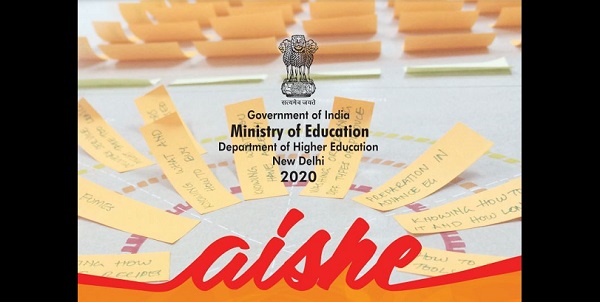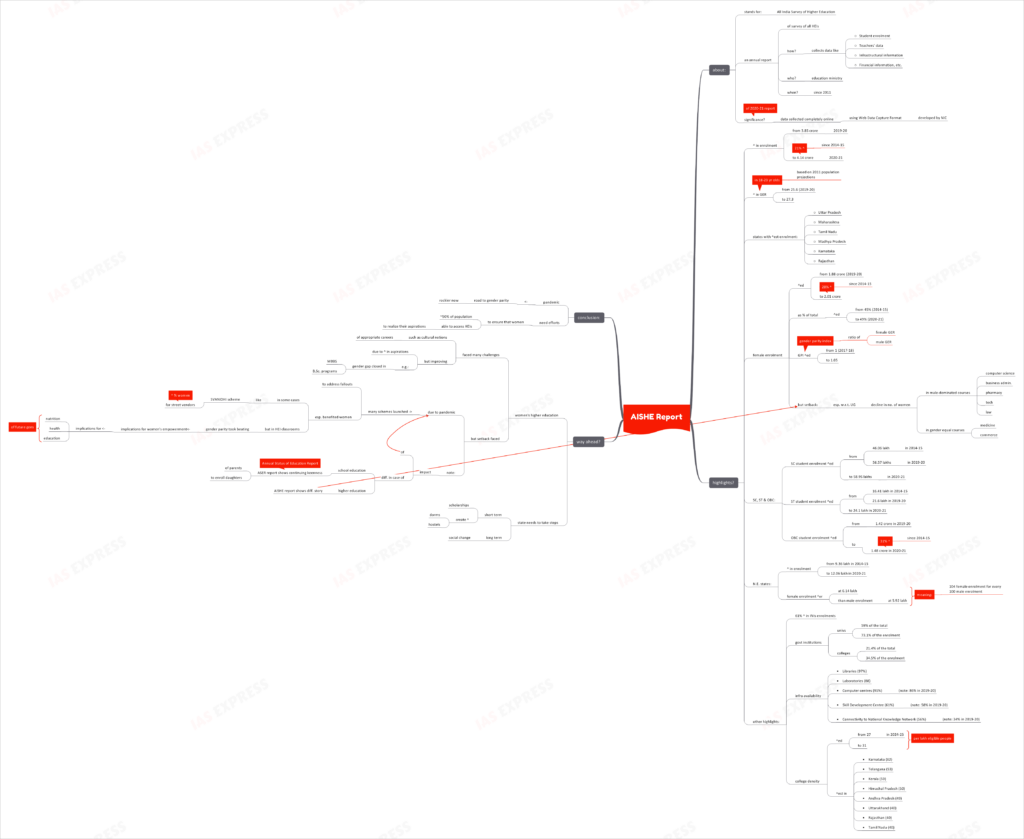AISHE (All India Survey of Higher Education) Report- Gender Equality Gains take a Hit

From Current Affairs Notes for UPSC » Editorials & In-depths » This topic
IAS EXPRESS Vs UPSC Prelims 2024: 85+ questions reflected
The recently released AISHE report for 2020-21 shows that the COVID-19 pandemic threatens to reverse the gains in gender equality with regards to higher education in India.

About the report:
- The AISHE (All India Survey of Higher Education) report is the result of the annual survey of all higher educational institutions by the Union Ministry of Education.
- These surveys are being undertaken by the ministry since 2011.
- It collects data such as:
- Student enrolment
- Teachers’ data
- Infrastructural information
- Financial information, etc.
- A notable fact about the recent survey (2020-21) is that the data from the educational institutions were collected entirely online using an online data collection platform relying on Web Data Capture Format developed by the NIC (National Informatics Center).
What are the highlights?
- Increase in student enrolment from 3.85 crore in 2019-20 to 4.14 crore in 2020-21. This marks a 21% increase since 2014-15.
- Gross Enrolment Ratio (GER) has increased from 25.6 (2019-20) to 27.3 in the 18-23 years age group, based on 2011 population projections.
- States with the highest enrolment:
- Uttar Pradesh
- Maharashtra
- Tamil Nadu
- Madhya Pradesh
- Karnataka
- Rajasthan
- On female enrolment:
- Increase in female enrolment from 1.88 crore (2019-20) to 2.01 crore. This is a 28% increase since 2014-15.
- The percentage of female enrolment in the total enrolment has risen from 45% (2014-15) to 49% (2020-21).
- The GPI/ Gender Parity Index has increased from 1 (2017-18) to 1.05.
- GPI is the ratio of female GER to male GER.
- Since 2017-18, the female GER has overtaken male GER.
- However, important gains achieved in the recent past have suffered a setback, especially with regards to the UG programs.
- Number of women in programs like computer science, business administration, pharmacy, technology and law courses have declined. These are courses where men are already in majority.
- Number of women in fields where the gender gap has largely been addressed, such as medicine and commerce, declined worryingly.
- On SC, ST & OBC:
- There has been an increase in enrolment of SC students from 46.06 lakh in 2014-15 and 56.57 lakhs in 2019-20 to 58.95 lakhs in 2020-21.
- The number of ST students enrolling also increased from 16.41 lakh in 2014-15 and 21.6 lakh in 2019-20 to 24.1 lakh in 2020-21.
- Increase in enrolment of OBC students from 1.42 crore in 2019-20 to 1.48 crore in 2020-21. This marks a 32% increase since 2014-15.
- In the North-eastern states:
- Increase in student enrolment from 9.36 lakh in 2014-15 to 12.06 lakh in 2020-21.
- Female enrolment has been higher than male enrolment since 2018-19. This continues in this survey too with the female enrolment being 6.14 lakh, while the male enrolment stood at 5.92 lakh- meaning, 104 female students enrolled for every 100 male students.
- Other highlights:
- 61% increase in enrolment in INIs (Institutes of National Importance) since 2014-15.
- While government universities account for 59% of the total, they contributed towards 73.1% of the enrolment. Similarly, government colleges contributed 34.5% of the enrolment while accounting for only 21.4% of the total.
- With regards to infrastructure availabilities at the HEIs surveyed:
- Libraries (97%)
- Laboratories (88)
- Computer centres (91%) (note: 86% in 2019-20)
- Skill Development Centre (61%) (note: 58% in 2019-20)
- Connectivity to National Knowledge Network (56%) (note: 34% in 2019-20)
- An increase in college density (number of colleges per lakh eligible population) from 27 in 2014-15 to 31.
- States with highest college density:
- Karnataka (62)
- Telangana (53)
- Kerala (50)
- Himachal Pradesh (50)
- Andhra Pradesh (49)
- Uttarakhand (40)
- Rajasthan (40)
- Tamil Nadu (40)
What is the way ahead?
- Women’s higher education has historically faced a gamut of impediments, such as cultural notions of what careers are appropriate for the gender.
- Fortunately, recent increase in aspirations has been steadily improving classrooms’ compositions. For instance, the gender gap in MBBS and B.Sc programs are considered closed.
- However, the pandemic seems to have thrown a hammer in the works. It is to be noted that its impact has been different in women’s higher education compared to its impact on school education.
- The ASER report shows that the pandemic’s fallouts haven’t diminished parents’ keenness to enrol their daughters in schools. The AISHE report tells a different story about higher education.
- The government launched a number of welfare schemes and measures to address equity-related issues, in the wake of the COVID-19 pandemic. Many of these especially helped women, as in case of the SVANIDHI scheme for street vendors (women constitute a significant percentage).
- However, the gender parity is still skewed in HEIs’ class rooms and this has implications for women’s empowerment- something that has a bearing on health, nutrition and education of the future generations.
- It is vital for the State and the HEIs to encourage women to return to the college and university classrooms.
- In the short-term, this calls for scholarships, establishment of more dorms and hostels, etc.
- In the long run, it requires the HEIs to catalyse a social change to enable girls to take up higher education and attain their aspirations.
Conclusion:
The pandemic has made the road to gender parity rockier than before. Efforts are required to ensure that women, constituting half the population, are able to access HEIs to realize their aspirations.
Practice Question for Mains:
What are the major findings of the recent AISHE report? What is the way ahead? (250 words)
If you like this post, please share your feedback in the comments section below so that we will upload more posts like this.

